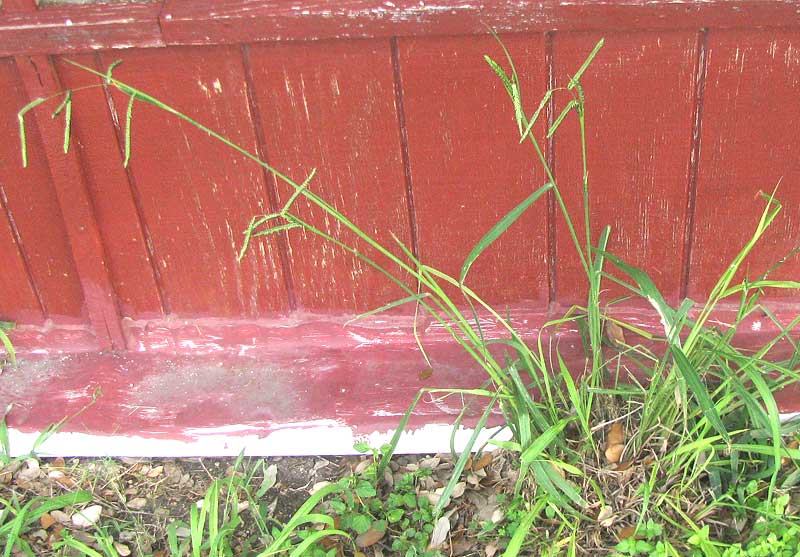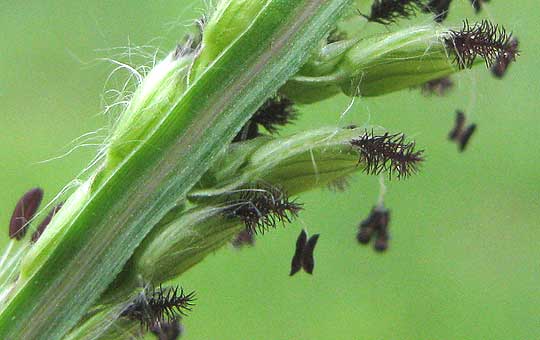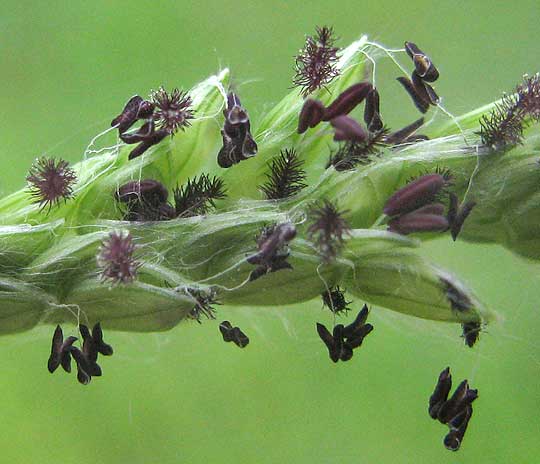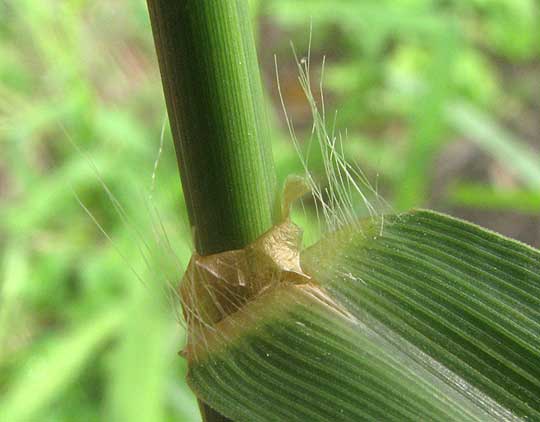Excerpts from Jim Conrad's
Naturalist Newsletter

from the July 7, 2013 Newsletter issued from the Frio Canyon Nature Education Center in the valley of the Dry Frio River in northern Uvalde County, southwestern Texas, on the southern border of the Edwards Plateau; elevation ~1750m (~5750 ft); N29.62°, W99.86°; USA
DALLISGRASS
Up against the red-painted wall of the valley cabin I lived in this winter nowadays a handsome grass is flowering, shown above.
The manner by which the slender, green "fingers" dangle from tips of the main stems and are well separated from one another along the stem top constitutes a good field mark for a large group of common grasses often referred to as the paspalums, genus Paspalum. About 320 paspalum species are recognized, and most are native to the tropical and subtropical Americas. Certain paspalum species have become utilized as turf grasses, some are used as ground cover in areas of high salinity, and some are grown as livestock forage. So, is the paspalum beside the red cabin one of those? The way to know was to "do the botany" to get a name, then "look it up."
Another field mark for paspalum grasses is that their individual flowers, or spikelets, arise on short, slender pedicels from just one side of a long, ribbon-like "rachis," as shown below:

In that picture the items looking like black butterflies dangling on slender, white threads are pollen-producing anthers, and the fuzzy, black items issuing from the tops of florets are pollen-catching stigmas. Notice the very long, white hairs arising along the florets' sides. Such long, cobwebby hairs are so unusual that they constitute an important field mark for this species.
You can see how the florets arrange themselves beneath the ribbonlike rachis below:

When "doing the botany" on a grass, it's always a good idea to check out the "ligule," which is an interesting feature arising at the very base of a blade of grass where it makes contact with the stem. You can see this grass's ligule below:

Some grass species have ligules formed only of various kinds of hairs, others have papery ears, sometimes the ears are toothed, or tattered, or without features, and sometimes there are no ligules at all. Our paspalum's ligules are a little unusual in that they consist of both long hairs and papery ears.
Especially because of the long hairs arising along the florets' sides, our cabin-side paspalum keys out very quickly to PASPALUM DILATATUM, mostly known as Dallisgrass in English. At first I thought the name was referring to Dallas, Texas, but in fact the name honors A.T. Dallis, who imported the species into the US from its homeland in Uruguay and Argentina, promoting it as a fast growing forage plant able to thrive in the hot, humid US southern states.
As it turned out, the grass grew too well, and now has become a weed, especially antagonizing those who think that monocultured, crewcut lawns are desirable. Dallisgrass is shaggier than what lawn owners like to see. It's a perennial that grows in ever enlarging circular clumps, sometimes becoming so large that the clump centers die out while the outer rings continue smothering all turf grasses they overgrow. Dallisgrass's short rhizomes root easily in moist soil, making it difficult to control. In our area I suspect that the species enjoys a better reputation than farther east, since ranchers like just about anything that will grow in this arid land and which their cattle like to eat.
Paspalums in general produce grains cherished by many small, seed-eating birds.